Discover the Advantages of Memory Foam Pocket Spring Mattresses
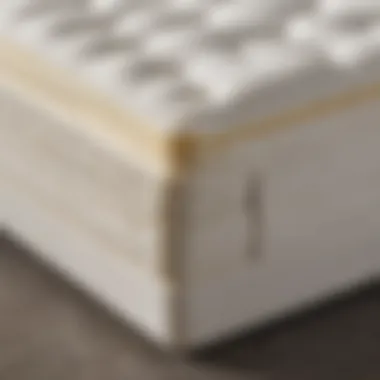
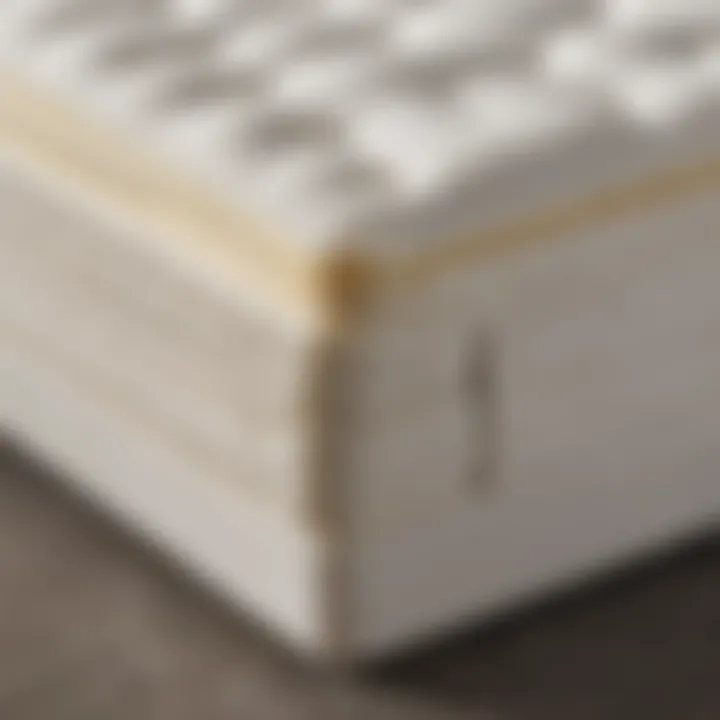
Intro
Memory foam pocket spring mattresses have gained popularity among consumers seeking improved sleep quality. These mattresses combine the contouring comfort of memory foam with the support and breathability of pocket spring technology. This dual construction aims to enhance the overall sleeping experience by addressing key issues such as pressure relief and spinal alignment.
In this article, we will explore various aspects of these mattresses, beginning with current trends in the market that reflect consumer preferences. We will then delve into the unique features of memory foam pocket spring mattresses, assess their advantages and disadvantages, and provide insights into the selection process and maintenance tips. By the end, readers will possess a comprehensive understanding of this bedding option, enabling them to make informed choices for their sleep environments.
Current Trends
With an ever-evolving landscape in mattress design, several trends have emerged in the realm of memory foam pocket spring mattresses.
Color Palettes
The choice of color can impact the overall aesthetic of a bedroom. Neutral tones such as gray, beige, and white remain popular. These colors create a calming atmosphere. Some consumers are also opting for muted blues and greens to bring a hint of color while maintaining a serene environment.
Popular Styles
Memory foam pocket spring mattresses come in various styles, appealing to different preferences. For instance, luxury models often feature higher layers of memory foam for added comfort. Other popular styles include adjustable models, which can cater to individual preferences regarding firmness and comfort level. Some users prefer a firmer feel, while others lean towards a softer surface.
"Selecting the right mattress style can significantly enhance your sleeping experience and overall well-being."
These current trends are reflective of a conscious movement towards personalization in sleep products, demonstrating that consumers are not just looking for comfort but also for aesthetic harmony in their living spaces.
Visual Ideas
Imagery plays a crucial role in inspiring choices for your home. A well-designed bedroom reflects personal taste while simultaneously promoting restfulness.
Gallery of Styled Bedrooms
Visual inspiration can be found in a curated gallery showcasing different bedroom styles that utilize memory foam pocket spring mattresses. Consider featuring various themes, such as minimalist designs, contemporary aesthetics, or cozy rustic spaces where these mattresses serve as the centerpiece.
Before-and-After Transformations
Documenting transformations enhances the value of visual ideas. Showcasing before-and-after images of spaces incorporating memory foam pocket spring mattresses can illustrate the significant impact that a quality mattress can have on the overall feel of a bedroom. Such visuals provide a tangible sense of the potential improvements in both style and comfort.
Understanding Memory Foam Pocket Spring Mattresses
The realm of sleep products can be overwhelming, yet understanding memory foam pocket spring mattresses is essential for making an informed purchasing decision. These mattresses uniquely combine the comforting properties of memory foam with the support of pocket spring technology. This distinction is not merely a marketing gimmick; it offers a range of benefits that enhance overall sleep quality and comfort. With varied options available, it's crucial to comprehend how the fusion of these materials works to cater to individual sleep preferences.
Defining Memory Foam
Memory foam is a viscoelastic material, initially developed for NASA in the 1960s, designed to absorb impact and distribute weight evenly. This special foam reacts to heat and pressure, allowing it to mold to the shape of the body. Thus, it offers great relief for pressure points, making it popular among those seeking comfort during sleep. When one lies down, the memory foam adapts, cradling the body while also providing support. This unique characteristic allows for a more restful night, as it helps in reducing tossing and turning.
What Are Pocket Springs?
Pocket springs are individual springs encased in fabric pockets. This design allows each spring to move independently, responding to body pressure and movements. As a result, pocket spring mattresses provide targeted support, promoting spinal alignment. They reduce motion transfer from one side of the bed to the other, which is beneficial for couples. If someone shifts during the night, the other partner often feels less disturbance, leading to better sleep quality for both.
Combining Technologies
Combining memory foam with pocket springs results in a sophisticated approach to mattress design. The top layer of memory foam offers contouring comfort, while the underlying pocket springs provide robust support structure. This harmonious configuration allows for an optimal sleep surface. The foam cushions the body, alleviating pressure, whereas the springs contribute to support and responsiveness. Additionally, the combination addresses different body weights and sleeping positions effectively, making it suitable for a diverse audience.
"The best sleep is achieved through a balanced support system that caters to individual needs."
In summary, understanding these key components is vital. As potential buyers evaluate their needs, grasping how memory foam and pocket springs work together can significantly influence their choice in purchase. It leads to a deeper appreciation of the options available in the marketplace.
Advantages of Memory Foam Pocket Spring Mattresses
Memory foam pocket spring mattresses serve as a noteworthy advancement in bedding technology, merging two distinct elements to provide numerous advantages. These mattresses harmoniously blend the conforming abilities of memory foam with the robust support of pocket springs. This combination aims to cater to various sleep needs, emphasizing comfort, support, and temperature control.
Enhanced Comfort
One of the most prominent benefits of memory foam pocket spring mattresses is the unparalleled comfort they offer. Memory foam contours to the body's shape, providing individualized support. This design helps distribute body weight evenly, reducing pressure points. Consequently, many users report a marked improvement in sleep quality, as they experience less tossing and turning throughout the night.
Moreover, the pocket springs add an additional layer of comfort. They work independently, which means they respond to the body's movements rather than moving as a collective unit. This feature significantly minimizes motion transfer, making it an ideal choice for couples who may have differing sleep patterns. The result is a soothing sleeping environment that promotes restful sleep.
Support and Alignment
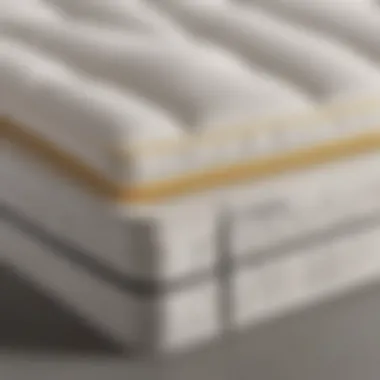
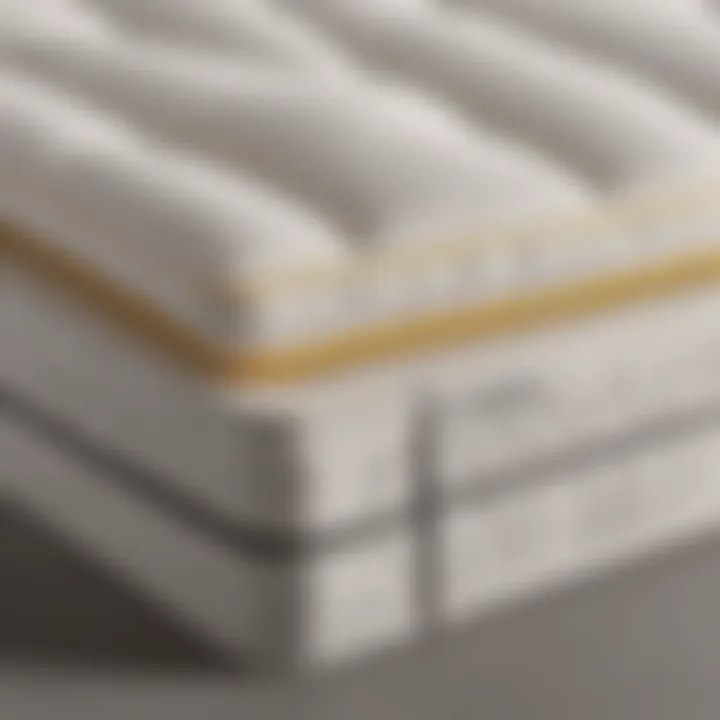
Supporting the body’s natural alignment is essential for preventing discomfort and ensuring a good night's sleep. Memory foam pocket spring mattresses efficiently provide this support. The combination of materials ensures that the body is properly aligned regardless of sleeping position.
For instance, the memory foam reacts to pressure and weight, cradling the spine, hips, and shoulders. Meanwhile, the pocket springs contribute to overall stability, enhancing spinal alignment. This aspect is particularly important for those with back pain or similar issues. By maintaining this alignment, the risk of developing chronic pain may be reduced over time, benefitting both health and well-being.
Temperature Regulation
Temperature regulation is another aspect where memory foam pocket spring mattresses excel. Traditional memory foam tends to retain heat, which can lead to discomfort during the night. However, the integration of pocket springs introduces airflow through the mattress. This design promotes better ventilation, allowing heat to dissipate more effectively.
In addition, some manufacturers enhance their memory foam with cooling gel or other materials designed to regulate temperature. This innovation ensures that the mattress not only supports but also keeps the sleeper cool. The result is a comfortable sleep environment, suitable for various climates and personal preferences.
As many users experience disrupted sleep due to overheating, this feature is invaluable for maintaining a conducive sleep atmosphere.
Disadvantages to Consider
While memory foam pocket spring mattresses offer various benefits, it is equally important to evaluate their disadvantages. Understanding these drawbacks can help consumers make more informed choices. Each disadvantage plays a role in how the mattress will perform in different sleep environments and can affect overall satisfaction.
Potential Heat Retention
One significant concern with memory foam pocket spring mattresses is their ability to retain heat. Memory foam materials are known for their density and conforming properties, which can create a warm sleeping surface. This heat retention might be uncomfortable for some people, particularly those who naturally sleep hot or live in warmer climates.
With less airflow through the material, heat can become trapped against the body. This can lead to disturbances during sleep, making it harder to find a comfortable temperature.
What to Consider: Individuals who are prone to overheating may want to explore options with cooling gel layers or breathable covers, as these features can help dissipate heat accumulation.
Weight and Mobility
Memory foam pocket spring mattresses are generally heavier than traditional spring mattresses. This added weight can be an issue during setup and regular maintenance. If you frequently change your bedding or move your mattress, the heaviness might make these tasks more cumbersome.
Additionally, if you live in an apartment or a place with narrow stairways or doorways, moving the mattress could be a challenge. Weight affects not just mobility, but also transportability when it comes to moving or rearranging your living space.
Suggestions: Before purchasing, consider the logistics of moving the mattress into your home. If you anticipate relocating frequently, a lighter mattress may better suit your lifestyle.
Initial Off-Gassing
Another aspect to keep in mind is the initial off-gassing that can occur with memory foam mattresses. Off-gassing refers to the release of volatile organic compounds (VOCs), which may produce a noticeable odor when the mattress is first unpacked. Although this odor generally dissipates within a few days, individuals sensitive to smells may find it unpleasant.
Health Considerations: While off-gassing is typically not a health hazard, those with respiratory issues or chemical sensitivities should take caution. Ventilating the room or waiting a few days before sleeping on the mattress may be wise.
Always check the manufacturer's guidelines regarding off-gassing and proper setup to ensure a safe sleeping environment.
In summary, while memory foam pocket spring mattresses offer many advantages, it is crucial to be aware of their disadvantages. Evaluating heat retention, weight, and initial off-gassing can better inform a purchase decision. These considerations help tailor the mattress choice to individual needs, ensuring a more satisfactory sleep experience.
Choosing the Right Mattress
Selecting the correct mattress is a critical decision that can significantly impact your overall sleep quality and health. With various mattress types available, including memory foam pocket spring mattresses, it becomes essential to understand your unique requirements before making a purchase. A well-chosen mattress not only promotes better sleep but can also alleviate aches, pains, and stress. Therefore, it is paramount to consider factors such as firmness levels, motion isolation, and durability.
Assessing Firmness Levels
Firmness is an essential aspect when choosing a mattress. This varies between soft, medium, and firm options. Each level provides a different feel and support level based on individual preferences. For instance, a softer mattress may be suitable for side sleepers since it allows for better contouring of the body, reducing pressure points on the shoulders and hips. Conversely, back and stomach sleepers may find more benefit in a firmer mattress as it promotes spinal alignment and support.
When assessing firmness, it is also crucial to consider your body weight and size. Heavier individuals typically require a firmer mattress to ensure adequate support. Softer mattresses may not provide enough resistance, leading to increased sagging and discomfort.
Considering Motion Isolation
Motion isolation refers to how well a mattress absorbs movement. This feature is particularly important for couples sharing a bed. When one partner moves, the other can be disturbed if the mattress does not excel in motion isolation. Memory foam pocket spring mattresses are generally superior in this aspect. The pocket springs minimize motion transfer, while the memory foam contours to your body shape, providing stability. Thus, if one person shifts during the night, the other is less likely to notice the movement, leading to a more restful sleep experience for both.
Evaluating Durability
Durability is another significant factor when selecting a mattress. A long-lasting mattress provides better value, as it reduces the frequency of replacements. Memory foam pocket spring mattresses typically offer a good balance of durability and comfort. However, this varies based on the quality of materials used in the construction. High-density memory foam coupled with high-quality pocket springs improves the mattress's lifespan substantially.
Regular maintenance also contributes to a mattress's durability. By rotating your mattress every few months and using a mattress protector, you can extend its lifespan and maintain its comfort level for a longer period.
"A quality mattress tailored to personal needs can significantly enhance sleep, contributing to overall health and wellbeing."
In summary, choosing the right mattress involves understanding your sleep habits and preferences. From assessing firmness levels to considering motion isolation and durability, each decision plays a role in finding the best memory foam pocket spring mattress for your needs. Taking the time to evaluate these factors will ultimately lead to improved sleep quality.


Maintenance Tips for Longevity
Maintaining a memory foam pocket spring mattress is crucial for ensuring its longevity and preserving its comfortable and supportive features. Proper care can prevent premature wear, preserve the structure, and enhance the overall sleeping experience. Regular maintenance also safeguards your investment in this technology, making it a worthwhile endeavor. By following some essential maintenance practices, homeowners can enjoy their mattress to the fullest.
Proper Cleaning Techniques
To maintain cleanliness, begin with regular vacuuming. Use a vacuum cleaner with an upholstery attachment to gently remove dust, dirt, and allergens from the surface of the mattress. Avoid vigorous scrubbing, as the foam can be sensitive. It is advised to spot clean any stains using mild soap and water. Dab, don’t rub, the affected area with a clean, damp cloth. Ensure the mattress dries completely before covering it again.
Using Mattress Protectors
A mattress protector acts as a barrier against spills, stains, and allergens. This layer not only keeps the mattress clean but also minimizes wear and tear. Choose a breathable protector that aligns with the temperature regulation properties of memory foam. It is also useful for allergy sufferers, as it reduces the impact of dust mites and other irritants. Regularly wash the mattress protector according to manufacturer instructions to maintain hygiene and freshness.
Routine Rotation Guidelines
To prevent uneven wear, regularly rotate the mattress. This practice helps distribute weight more evenly, prolonging the lifespan of both the foam and springs. Plan to rotate the mattress every three to six months. It is also wise to flip the mattress, if the design allows, as this can further enhance its durability.
Routine maintenance not only prolongs the life of your mattress but also ensures a healthier sleeping environment.
These simple yet effective maintenance tips will help preserve the quality of a memory foam pocket spring mattress, ensuring it remains a valuable part of the home for years to come.
Comparing Options
When it comes to selecting a mattress, a comparative analysis is essential. This section highlights the approaches needed to assess memory foam pocket spring mattresses against other prevalent types. Understanding the various mattress options allows consumers to make educated choices tailored to their individual needs. Factors such as comfort, support, and durability are vital in comparison discussions.
Memory Foam vs. Innerspring
Memory foam and innerspring mattresses represent two of the most traditional sleeping solutions. Innerspring mattresses consist of metal coils which provide a foundational support structure. These mattresses are known for being bouncy and generally cooler because of the spaces between coils that facilitate airflow. Some individuals prefer this type for its responsiveness. However, they might not provide the same level of contouring support that memory foam offers.
Conversely, memory foam mattresses are known for their ability to conform to the body’s shape. This property aids in distributing weight evenly and alleviating pressure points. As a result, memory foam can provide considerable support for spinal alignment. Many consumers appreciate the heightened comfort that memory foam can offer, especially for side sleepers. Nonetheless, it may retain heat, which can be uncomfortable during sleep. It is important to assess personal preferences regarding firmness levels and sleeping styles before making a final decision.
Memory Foam vs. Latex
Latex mattresses, which can be made from natural or synthetic materials, differ significantly from memory foam. One key advantage of latex is its responsiveness. It tends to bounce back more quickly than memory foam, providing a more buoyant feel. Additionally, latex typically offers greater breathability and thus can help maintain a cooler sleeping surface.
Memory foam's advantage lies in its ability to contour to the body, offering targeted support. Latex mattresses often provide a firmer surface than memory foam, which may suit those who prefer more stability. Both types of mattresses have longer lifespans compared to traditional innerspring options. Assessing the benefits of durability, feel, and cost will aid in determining which material suits individual needs best.
Pocket Spring vs. Traditional Spring
Pocket spring mattresses utilize independently wrapped springs, allowing each coil to react independently to body weight. This means less motion transfer. As a result, partners sleeping on a pocket spring mattress tend to be less disturbed by each other's movements. Traditional spring mattresses, on the other hand, use interconnected coils. This design can create a feeling of less individual support and may lead to more motion transfer.
The choice between pocket spring and traditional spring may hinge upon comfort preferences and sleeping arrangements. Pocket spring models often offer enhanced support and adjustability, making them a preferred choice for many. However, traditional springs are typically less expensive. Thus, understanding personal needs and priorities in sleep quality can guide consumers in making an informed choice.
Health Considerations
Understanding health considerations when choosing a mattress is critical. Different aspects of a mattress can impact sleep quality, addressing specific sleep disorders, and even allergy sensitivities. For many, the right mattress can significantly enhance well-being and sleep comfort, making it an essential topic in this guide.
Impact on Sleep Quality
Sleep quality is influenced by many factors, and the mattress is one of the most crucial. Memory foam pocket spring mattresses, thanks to their unique construction, offer a blend of support and comfort. The memory foam conforms to the body, relieving pressure points while maintaining a supportive structure due to the pocket springs.
Research suggests that better sleep quality can lead to improved mental clarity and overall health. Studies show that a supportive mattress reduces tossing and turning, allowing individuals to reach deeper sleep stages. Consequently, these mattresses are often recommended for individuals suffering from frequent sleep disturbances.
Addressing Sleep Disorders
Certain sleep disorders, like insomnia and sleep apnea, can be exacerbated by an inappropriate mattress. The design of memory foam pocket spring mattresses provides stability and reduces movement transfer between partners. This design supports uninterrupted sleep, which can be beneficial for those suffering from conditions like restless leg syndrome or chronic back pain.
It is essential to consult with healthcare professionals about the best mattress types for specific disorders. Each person may have unique needs regarding firmness and materials that warrant careful consideration.
Considerations for Allergies
For individuals with allergies, the choice of mattress materials is vital. Memory foam is naturally hypoallergenic, which makes it an excellent option for those sensitive to allergens. Additionally, pocket springs allow for better airflow compared to traditional innerspring mattresses, potentially reducing the accumulation of dust mites and other allergens.
It is also wise to consider the mattress cover material. A breathable, hypoallergenic cover can add an extra layer of protection against irritants. Proper maintenance and regular cleaning can further help in keeping allergens at bay.
Choosing a mattress is not just about comfort; it's about enhancing your overall health and well-being.

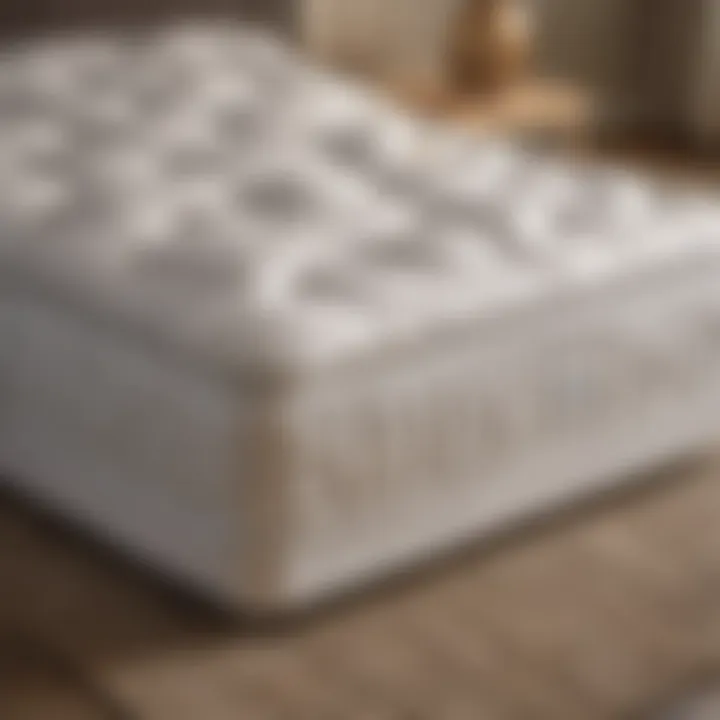
In summary, health considerations regarding memory foam pocket spring mattresses are multi-faceted. Their impact on sleep quality, ability to address specific sleep disorders, and suitability for allergy sufferers make them an essential choice. Understanding these factors enables informed decision-making, leading to better sleep and health outcomes.
Economic Factors
The economic considerations around memory foam pocket spring mattresses are vital for consumers. These factors significantly influence purchasing decisions, particularly when evaluating the long-term value of an investment in sleep quality. By understanding the economic implications, one can assess not only the upfront costs but also the potential savings and benefits accrued over time.
Cost Analysis
When considering a mattress purchase, the initial price is often the first thing to evaluate. Memory foam pocket spring mattresses can range widely in price. Factors influencing the cost include brand reputation, materials used, and unique features such as cooling technologies or enhanced support systems. It's essential to note that a higher price does not always guarantee superior comfort or durability. On average, a quality memory foam pocket spring mattress may cost between $800 to $2,500.
Consumers should look at prices across various retailers and weigh performance against cost to find the best mattress for their needs. Sales, discounts, and warranties should also be taken into account during this evaluation period.
Warranty and Value
Warranties play a significant role in determining the value of a mattress. Typically, reputable brands offer warranties ranging from 10 to 25 years. This indicates the company's confidence in its product’s durability and quality. A strong warranty can be a safeguard against potential manufacturing defects and premature wear.
Along with the warranty, understanding the return policy is crucial. A generous return policy can allow customers to test the mattress in their own home. This is particularly important for memory foam mattresses, as it can take time to fully adjust. Assessing both warranty and return options ensures better long-term satisfaction.
Long-Term Investment Considerations
Investing in a memory foam pocket spring mattress should be viewed as a long-term commitment to improved sleep health. While the upfront cost may seem daunting, the investment often pays off in terms of sleep quality and overall well-being. Poor sleep can have significant implications for health, leading to decreased productivity and increased medical expenses.
Consider how many hours are spent in bed. A quality mattress should last around 7-10 years with proper care. If one calculates the cost of the mattress over its lifespan, it becomes clear that a higher-quality mattress can yield a lower cost per use.
"Investing in a memory foam pocket spring mattress is investing in better health."
Additionally, energy savings are another subtle financial benefit. A good mattress can facilitate more restful and uninterrupted sleep. This reduces the need for expensive sleep aids or treatments later. Overall, understanding these economic factors empowers consumers to make informed decisions when purchasing a mattress.
Consumer Reviews and Insights
Consumer reviews and insights play a crucial role in understanding the effectiveness and appeal of memory foam pocket spring mattresses. They offer real-world experiences from individuals who have invested in these products. Many people seek these reviews before making a purchase, as they provide valuable contextual information. This section will delve into the importance of gathering insights from consumers, exploring the nuances that can inform potential buyers.
Analyzing User Experiences
User experiences vary significantly, and each review contributes a unique perspective. Many users appreciate the comfort and support provided by memory foam pocket spring mattresses. Findings indicate that several consumers report better sleep quality. Feedback often highlights features such as impressive motion isolation, where movement on one side does not disturb the other. These insights help potential buyers to gauge how well the product may meet their specific needs.
Additionally, it is essential to consider the demographics of the consumers when analyzing reviews. Young couples may prioritize pressure relief, while older individuals may focus on support and ease of movement. Different needs call for different evaluations, so aggregating user reviews can help in drawing broader conclusions as to how these mattresses cater to various lifestyles.
Expert Opinions
Expert opinions provide an added layer of credibility to consumer reviews. Experts, such as sleep researchers and product testers, often highlight the technological aspects of memory foam pocket spring mattresses. They may discuss qualities like the quality of materials used in the memory foam, the construction of pocket springs, and their overall impact on spinal alignment.
Several well-regarded publications also carry out unbiased testing of mattresses, which can reveal insights not covered in typical user reviews. For example, product reviews may include evaluations on breathability and durability, offering a more comprehensive understanding of the mattress's life span. In summary, expert reviews complement consumer opinions and provide a balanced perspective on the product's overall performance.
Common Feedback Themes
The feedback from consumers often revolves around specific themes, providing insight into the strengths and weaknesses of memory foam pocket spring mattresses. Common themes include:
- Comfort: Many users mention the initial comfort as a strong point, noting its ability to contour to the body.
- Support: A frequent observation is the excellent support provided, particularly for those with back pain.
- Heat Retention: Some reviews note the issue of heat retention, with users expressing concerns about sleeping hot. However, others report satisfaction with the cooling technology that some brands incorporate.
- Value for Money: Many users feel the balance of quality and cost is favorable, particularly compared to traditional mattresses.
These common feedback themes not only reflect the varying experiences of different users but also help guide potential buyers in their decision-making process. Readers can align their personal priorities with the experiences and insights shared by others to make informed choices.
Future of Mattresses
The mattress industry is evolving, reflecting changes in consumer preferences, technology, and environmental awareness. The future of mattresses is significant because it shapes how we will sleep and rest, impacting our health and lifestyle. Memory foam pocket spring mattresses combine the comfort of memory foam with the support of pocket springs. This hybrid design offers advantages that align with future trends in the mattress market.
Technological Innovations
One of the most exciting aspects of mattress development is the incorporation of technological innovations. Many brands are exploring how smart technology can enhance sleep quality. Some mattresses now feature sensors that track sleep patterns and adjust firmness levels automatically. This adaptability helps in optimizing individual comfort.
Furthermore, advancements in memory foam technology have led to products with better breathability. Innovative cooling gels infused in the foam prevent overheating during the night. It’s essential for modern users, as concerns about temperature regulation have been a common complaint.
The integration of advanced materials, such as antimicrobial fabrics, improves hygiene and longevity. These features respond to increasing awareness of health issues, ensuring that mattresses can meet the demands of a more health-conscious society. Overall, technological progress is key in enhancing the functionality of mattresses.
Sustainability Trends
As the world becomes increasingly aware of environmental issues, sustainability is at the forefront of consumer choices, including mattresses. The future of mattresses features a noticeable shift towards eco-friendly materials. Many manufacturers are turning to natural and organic materials in their products. Latex, sourced from rubber trees, is often combined with memory foam to enhance sustainability.
Moreover, companies focus on reducing their carbon footprint during production. This includes minimizing waste and using recyclable packaging. Regulatory pressure also pushes manufacturers to adopt sustainable practices. Consumers are now more likely to choose products with environmentally friendly certifications.
"Sustainability in mattress production reflects a broader trend towards responsible consumption that more and more people are supporting."
Ultimately, the future of mattresses will reflect a balance between comfort, innovation, and sustainability. As more consumers demand mattresses that are not only comfortable but also eco-friendly, manufacturers will need to adapt to these preferences to remain competitive. The trends are clear: the future holds exciting possibilities for creating products that not only meet consumer needs but also respect the planet.



